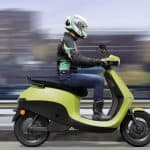Electric bikes have become a popular mode of transportation in recent years, offering a convenient and eco-friendly alternative to traditional bikes. However, their presence on city bike paths has raised some questions about their classification and the rules that govern their usage. Are electric bikes considered motorized vehicles? And if not, how are they allowed on bike paths?
Contrary to popular belief, electric bikes do not fall into the motorized vehicle category. According to the Altoona Police Department, an electric bike must have pedals and an attached electric motor of 750 watts or less to be classified as such. This distinction sets them apart from electric motorcycles, which are not allowed on city bike paths, trails, or parks.
Interestingly, while electric bikes are permitted on city trails, the same cannot be said for other motorized modes of transportation such as skateboards and electric scooters. This highlights the unique position of electric bikes, which strike a balance between traditional bicycles and fully motorized vehicles.
However, the integration of electric bikes on bike paths brings about the need for awareness and consideration from all users. Steve Plaza, the Parks, Forestry, and Cemetery manager, emphasizes the importance of being mindful of one’s surroundings. When approaching others from behind, it is crucial to communicate your presence effectively. Whether by ringing a bell or politely calling out “passing on your left” or “passing on your right,” these simple actions can prevent startling pedestrians or fellow cyclists.
Furthermore, pedestrians should also remain vigilant when sharing bike paths with electric bike riders. This is particularly significant when children are involved, as they may be less experienced in navigating these paths. By staying alert and aware, everyone can contribute to a safe and enjoyable experience for all users.
In conclusion, electric bikes offer a unique mode of transportation that bridges the gap between traditional bicycles and motorized vehicles. While they are not classified as motorized vehicles, certain guidelines and considerations apply when using them on city bike paths. By adhering to these rules and practicing awareness, electric bike riders can enjoy the benefits of their chosen mode of transportation while ensuring the safety and enjoyment of others on the path.
The electric bike industry has experienced significant growth in recent years, driven by the increasing demand for eco-friendly transportation options. According to market forecasts, the global electric bike market is projected to reach a value of $38.6 billion by 2025, with a compound annual growth rate (CAGR) of 7.9% during the forecast period (source: Grand View Research).
One of the key drivers of this market growth is the rising awareness of environmental issues and the need to reduce carbon emissions. Electric bikes provide a sustainable alternative to cars and motorcycles, allowing individuals to commute and travel in a more eco-friendly manner. Additionally, the increasing popularity of cycling as a recreational activity has also contributed to the demand for electric bikes.
However, the electric bike industry also faces some challenges. One of the main issues is related to regulations and restrictions on their usage. The classification of electric bikes varies across different countries and regions, which can create confusion for both riders and authorities. Some countries have specific laws in place that define the maximum speed, power, and operation requirements for electric bikes. For example, in the United States, electric bikes are classified into three categories, with different restrictions and guidelines for each category (source: PeopleForBikes).
Another challenge is the perception of electric bikes by non-riders. Some individuals may view electric bikes as a potential safety hazard or an invasion of traditional bike paths. This can lead to conflicts between electric bike riders and other users of bike paths, such as pedestrians and cyclists. To address these concerns, it is important for electric bike riders to be considerate and practice good etiquette when sharing bike paths with others.
Overall, the electric bike industry has a promising future, fueled by the growing demand for sustainable transportation options. As more cities and communities invest in cycling infrastructure and promote the use of electric bikes, the market is expected to continue its upward trajectory. However, it is crucial for stakeholders to work together to address regulatory issues and promote responsible usage of electric bikes to ensure a safe and harmonious coexistence with other modes of transportation.







